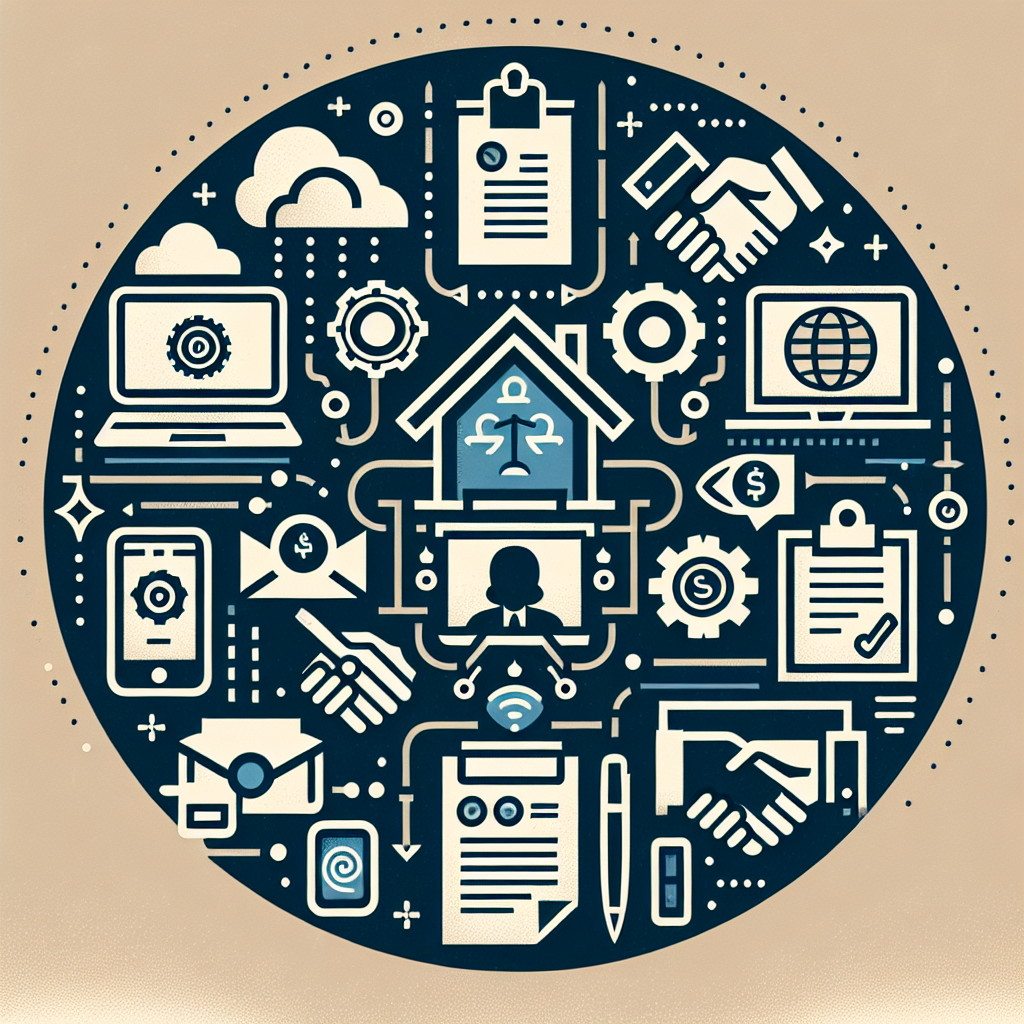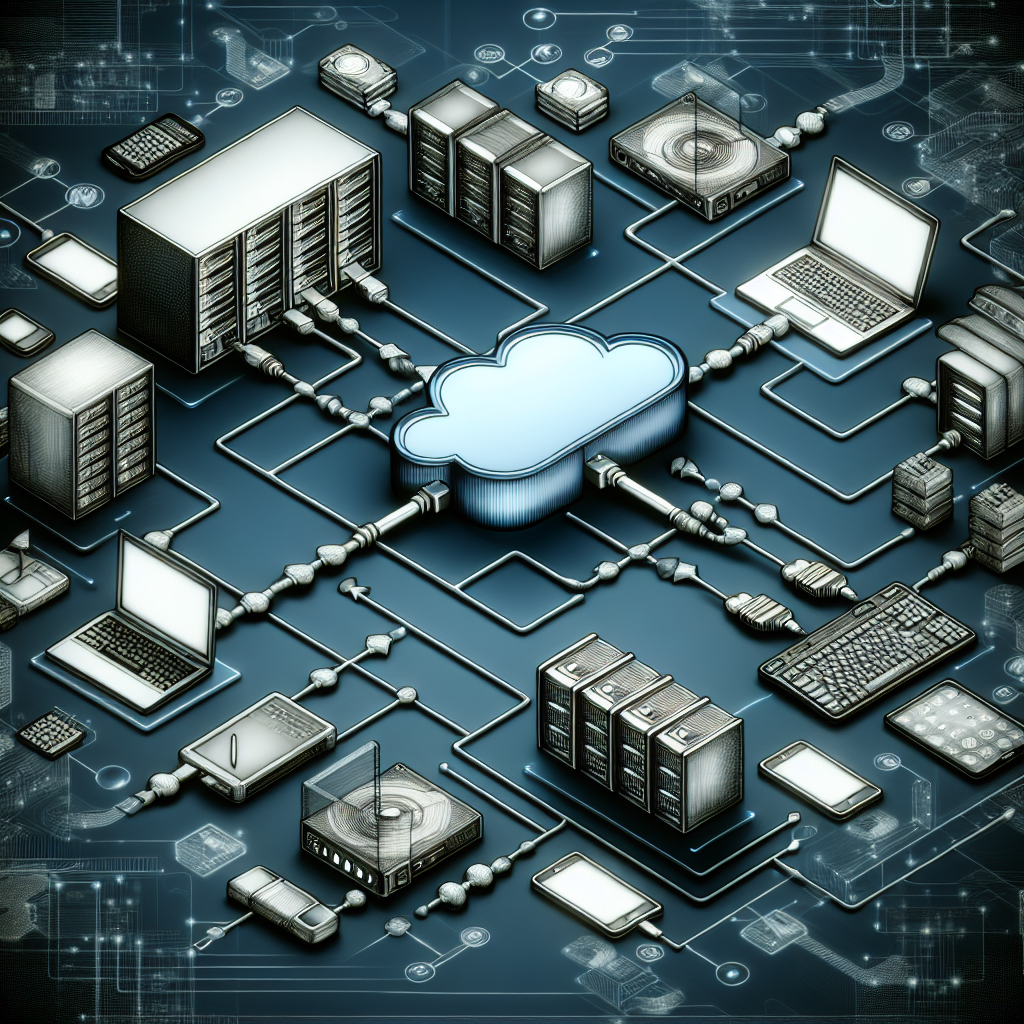Your cart is currently empty!
Tag: Work

Maximizing Remote Monitoring Tools for Remote Work Success
Remote work has become increasingly popular in recent years, with more and more companies allowing their employees to work from home. With the rise of remote work, the need for effective remote monitoring tools has also increased. These tools are essential for ensuring that employees are staying productive and on track, even when working from a different location.One of the key benefits of remote monitoring tools is that they give managers real-time visibility into their team’s work. This can help them identify any potential issues or roadblocks that may be hindering productivity. By monitoring employees’ activities, managers can also ensure that work is being completed on time and to a high standard.
There are a variety of remote monitoring tools available, ranging from time tracking software to employee monitoring software. Time tracking software allows employees to log their hours worked and track their progress on tasks. This can help employees stay organized and focused on their work, while also providing managers with valuable insights into how time is being spent.
Employee monitoring software, on the other hand, allows managers to track employees’ computer usage and activity. This can help ensure that employees are staying on task and not engaging in any non-work-related activities during work hours. While some may view employee monitoring as intrusive, it can be a valuable tool for ensuring productivity and accountability in a remote work setting.
To maximize the effectiveness of remote monitoring tools, it’s important for companies to set clear expectations and guidelines for their use. Employees should be informed of what will be monitored and how the data will be used. This can help alleviate any concerns about privacy and ensure that employees feel comfortable with the monitoring tools being used.
Additionally, companies should strive to use remote monitoring tools in a positive and constructive manner. Instead of using the tools to micromanage or spy on employees, they should be used to support and empower employees in their work. For example, managers can use the data from time tracking software to identify areas where employees may be struggling and offer additional support or resources.
Overall, remote monitoring tools can be a valuable asset for companies looking to maximize productivity and success in a remote work setting. By setting clear expectations, using the tools in a positive manner, and providing support to employees, companies can ensure that their remote teams are working efficiently and effectively.

Best Practices for Managing Service Level Agreements in a Remote Work Environment
As remote work becomes more prevalent in today’s workforce, businesses are faced with the challenge of managing service level agreements (SLAs) in a distributed work environment. SLAs are contractual agreements that outline the level of service that a provider will deliver to its customers, and remote work can complicate the monitoring and management of these agreements. However, with the right strategies in place, businesses can ensure that SLAs are met even in a remote work setting.One of the best practices for managing SLAs in a remote work environment is to establish clear communication channels. With team members working from different locations, it is crucial to have consistent and transparent communication to ensure that everyone is on the same page. This can include regular check-ins, virtual meetings, and the use of collaboration tools to track progress and address any issues that may arise.
Another important practice is to define key performance indicators (KPIs) that align with the SLAs. By setting specific metrics and targets, businesses can easily track performance and identify any areas that may need improvement. These KPIs should be communicated to all team members so that everyone understands their role in meeting the SLAs.
It is also essential to provide adequate training and support for remote workers. Working from home can present unique challenges, and employees may need additional resources or guidance to perform their tasks effectively. By investing in training programs and offering ongoing support, businesses can help remote workers meet SLAs and contribute to the overall success of the organization.
Additionally, businesses should consider implementing remote monitoring tools to track performance and ensure compliance with SLAs. These tools can provide real-time data on key metrics, allowing managers to identify any issues and take corrective action as needed. By leveraging technology, businesses can streamline the management of SLAs in a remote work environment and improve overall performance.
In conclusion, managing service level agreements in a remote work environment requires careful planning and communication. By establishing clear communication channels, defining KPIs, providing training and support, and leveraging technology, businesses can effectively monitor and manage SLAs in a distributed work setting. By following these best practices, businesses can ensure that remote workers meet SLAs and contribute to the success of the organization.

Exploring the Role of Remote Monitoring in Remote Work Environments
The way we work has changed dramatically in recent years, with more and more employees opting for remote work arrangements. This shift has been accelerated by the global COVID-19 pandemic, which forced businesses to adapt quickly to new ways of working. As remote work becomes the norm for many companies, the need for effective remote monitoring solutions has never been greater.Remote monitoring refers to the use of technology to track and monitor employees’ activities and productivity while working remotely. This can include monitoring internet usage, tracking work hours, and even monitoring employees’ computer screens in real time. While some may see remote monitoring as invasive or intrusive, it can actually play a crucial role in ensuring productivity, accountability, and security in remote work environments.
One of the key benefits of remote monitoring is its ability to provide managers with real-time insights into how their team members are working. By tracking employees’ activities and progress on tasks, managers can quickly identify any potential bottlenecks or issues that may be affecting productivity. This level of visibility can help managers make informed decisions about resource allocation, project timelines, and workflow optimization.
Remote monitoring can also help to ensure that employees are staying on task and meeting deadlines. By tracking work hours and monitoring internet usage, managers can easily identify any patterns of procrastination or time-wasting activities. This can help to hold employees accountable for their work and ensure that deadlines are being met consistently.
In addition to productivity benefits, remote monitoring can also enhance security in remote work environments. With the rise of cyber threats and data breaches, it’s more important than ever for companies to protect their sensitive information. Remote monitoring can help to detect and prevent unauthorized access to company systems and data, as well as identify any suspicious activity that may indicate a security breach.
While remote monitoring can provide numerous benefits for remote work environments, it’s important for companies to implement these systems thoughtfully and ethically. Employees should be made aware of the monitoring policies in place and should have the opportunity to voice any concerns or questions they may have. Transparency and communication are key to ensuring that remote monitoring is implemented in a way that respects employees’ privacy and fosters trust within the organization.
In conclusion, remote monitoring plays a crucial role in remote work environments by providing managers with valuable insights into employee productivity, accountability, and security. By leveraging technology to track and monitor employee activities, companies can ensure that remote work arrangements are successful and sustainable in the long term. As remote work continues to grow in popularity, the role of remote monitoring will only become more important in ensuring that companies can effectively manage and support their remote workforce.

Cybersecurity Risks in the Age of Remote Work
With the rise of remote work due to the ongoing COVID-19 pandemic, cybersecurity risks have become a major concern for businesses and individuals alike. As more employees work from home, they are increasingly using personal devices and unsecured networks, making them more vulnerable to cyber attacks. In this article, we will discuss the cybersecurity risks in the age of remote work and provide tips on how to protect yourself and your organization.One of the biggest cybersecurity risks in the age of remote work is the use of personal devices for work-related tasks. While this may be convenient for employees, it also opens up a host of security vulnerabilities. Personal devices are often not as secure as company-issued devices, and may not have the latest security updates installed. This makes them more susceptible to malware and other cyber attacks.
Another major risk is the use of unsecured public Wi-Fi networks. Many employees are working from cafes, airports, or other public places where Wi-Fi networks are not secure. Hackers can easily intercept data transmitted over these networks, putting sensitive information at risk. It is important for employees to use a virtual private network (VPN) when connecting to public Wi-Fi networks to encrypt their data and protect their online activities.
Phishing attacks have also become more prevalent in the age of remote work. Hackers are sending out malicious emails pretending to be from reputable organizations in order to trick employees into revealing sensitive information or downloading malware onto their devices. It is important for employees to be vigilant and verify the authenticity of any emails before clicking on links or providing personal information.
To protect yourself and your organization from cybersecurity risks in the age of remote work, here are some tips to follow:
1. Use strong, unique passwords for all your accounts and enable two-factor authentication whenever possible.
2. Keep your devices and software up to date with the latest security patches.
3. Use a VPN when connecting to public Wi-Fi networks to encrypt your data.
4. Be cautious of emails from unknown senders and do not click on links or download attachments from suspicious emails.
5. Educate yourself and your employees about cybersecurity best practices and the importance of maintaining good security hygiene.
In conclusion, the rise of remote work has brought about new cybersecurity risks that need to be addressed. By following the tips outlined in this article, you can help protect yourself and your organization from falling victim to cyber attacks. Stay vigilant, stay informed, and stay safe in the age of remote work.

Cloud Computing in the Age of Remote Work: How Businesses are Adapting
Cloud computing has been a game-changer for businesses in recent years, allowing them to store, access, and manage their data and applications remotely through the internet. However, in the age of remote work brought on by the COVID-19 pandemic, cloud computing has become even more crucial for businesses looking to adapt to the new normal.With the rise of remote work, businesses have had to quickly shift their operations online, with employees working from home and relying on cloud-based tools and services to collaborate and communicate effectively. Cloud computing has enabled businesses to maintain productivity and efficiency, even when employees are not physically present in the office.
One of the key benefits of cloud computing in the age of remote work is its scalability and flexibility. Businesses can easily scale their cloud resources up or down based on their needs, allowing them to adapt to changing workloads and requirements. This flexibility is especially important in a remote work environment, where businesses may need to quickly ramp up their resources to support a sudden increase in demand.
Another advantage of cloud computing is its cost-effectiveness. By moving their data and applications to the cloud, businesses can reduce their IT infrastructure costs, as they no longer need to invest in expensive hardware and software. Instead, they can pay for cloud services on a subscription basis, only paying for what they use. This pay-as-you-go model is particularly beneficial for businesses in the current economic climate, where cost savings are more important than ever.
In addition to cost savings, cloud computing also offers businesses increased security and reliability. Cloud service providers invest heavily in security measures to protect their customers’ data, ensuring that it is safe from cyber threats and breaches. This level of security is especially important in a remote work environment, where employees are accessing company data from various locations and devices.
Overall, cloud computing has become a lifeline for businesses in the age of remote work, enabling them to adapt quickly and effectively to the new normal. By harnessing the scalability, flexibility, cost-effectiveness, and security of the cloud, businesses can continue to operate seamlessly and stay ahead of the curve in an increasingly digital world.

Best Practices for Data Backup and Recovery in a Remote Work Environment
In today’s increasingly digital world, data backup and recovery have become crucial for businesses of all sizes. With the rise of remote work, ensuring that your data is securely backed up and easily recoverable is more important than ever. In this article, we will discuss some best practices for data backup and recovery in a remote work environment.1. Implement a reliable backup solution: The first step in ensuring the safety of your data is to implement a reliable backup solution. This could be a cloud-based backup service, an external hard drive, or a combination of both. Make sure that your chosen solution is automated, so that your data is backed up regularly without the need for manual intervention.
2. Encrypt your backups: In a remote work environment, data security is of utmost importance. Make sure that your backups are encrypted to protect them from unauthorized access. This will ensure that even if your data is compromised, it remains secure and inaccessible to cybercriminals.
3. Test your backups regularly: Simply having a backup solution in place is not enough – you also need to regularly test your backups to ensure that they are working as intended. This will help you identify any issues or gaps in your backup process before it’s too late.
4. Have a data recovery plan: In the event of a data loss, having a solid data recovery plan in place can make all the difference. This plan should outline the steps to be taken in the event of a data breach or loss, including how to restore your data quickly and efficiently.
5. Train your employees on data backup best practices: Your employees play a crucial role in ensuring the safety of your data. Make sure to train them on data backup best practices, including how to securely store and back up their data, and how to identify and report any potential data security threats.
6. Monitor your backups: Monitoring your backups regularly will help you identify any issues or failures in your backup process before they become major problems. Make sure to set up alerts for any issues, so that you can address them promptly.
In conclusion, data backup and recovery are essential for businesses operating in a remote work environment. By implementing the best practices outlined in this article, you can ensure that your data is securely backed up and easily recoverable, protecting your business from potential data loss and security threats. Remember, it’s better to be safe than sorry when it comes to protecting your valuable data.

How Cloud Computing is Revolutionizing Remote Work and Collaboration
Cloud computing has been a game-changer for businesses around the world, offering a more flexible, efficient, and cost-effective way to store, manage, and access data. But perhaps one of its most significant impacts has been on remote work and collaboration.In recent years, the rise of remote work has become a trend that shows no signs of slowing down. With advancements in technology and the increasing global connectivity, employees can now work from anywhere in the world, as long as they have an internet connection. This shift has been made possible, in large part, by the widespread adoption of cloud computing technology.
Cloud computing allows employees to access the same files, applications, and data from any device and any location, making remote work more seamless and efficient than ever before. Instead of being tied to a physical office, workers can collaborate in real-time, share documents instantly, and communicate effortlessly with colleagues around the globe.
One of the key benefits of cloud computing for remote work is the ability to access files and applications on-demand, without the need for physical servers or storage devices. This means that employees can work on projects collaboratively, even if they are thousands of miles apart. With cloud-based tools like Google Drive, Dropbox, and Microsoft Office 365, teams can edit documents simultaneously, track changes, and stay in sync with each other in real-time.
Additionally, cloud computing offers enhanced security features to protect sensitive data and prevent unauthorized access. With encryption, firewalls, and multi-factor authentication, businesses can ensure that their information is safe and secure, even when accessed remotely. This gives employees peace of mind knowing that their data is protected, no matter where they are working from.
Furthermore, cloud computing simplifies IT management for businesses, as updates, maintenance, and backups are handled by the cloud provider, freeing up time and resources for other important tasks. This means that remote employees can focus on their work, without having to worry about technical issues or downtime.
Overall, cloud computing has revolutionized remote work and collaboration by providing a flexible, efficient, and secure way for employees to work together from anywhere in the world. As businesses continue to embrace remote work as a viable option, cloud computing will play an even more significant role in shaping the future of work.

How Managed Service Providers Can Help Businesses Adapt to Remote Work
The COVID-19 pandemic has forced many businesses to quickly adapt to remote work in order to keep operations running smoothly. While some companies were already equipped to handle a remote workforce, many others have had to scramble to set up the infrastructure and tools needed for employees to work from home.This sudden shift to remote work has presented a unique set of challenges for businesses, including ensuring employees have access to the necessary technology, maintaining communication and collaboration, and ensuring the security of sensitive data. Managed service providers (MSPs) can play a crucial role in helping businesses navigate these challenges and adapt to the new normal of remote work.
MSPs are third-party organizations that provide a range of IT services and support to businesses. These services can include network monitoring, data backup and recovery, cybersecurity, and help desk support, among others. By partnering with an MSP, businesses can leverage their expertise and resources to address the specific needs of a remote workforce.
One of the key ways that MSPs can help businesses adapt to remote work is by ensuring employees have the necessary technology and support to work efficiently from home. This may involve setting up virtual private networks (VPNs) to secure remote connections, providing remote desktop support for troubleshooting technical issues, and ensuring employees have access to the software and tools they need to do their jobs effectively.
MSPs can also help businesses maintain communication and collaboration among remote teams. This can include setting up and managing video conferencing platforms, implementing collaboration tools such as project management software, and providing training and support to help employees navigate these new technologies.
In addition, MSPs can help businesses enhance their cybersecurity measures to protect sensitive data and prevent cyber threats. With employees working from various locations and devices, the risk of a data breach or security incident increases. MSPs can help businesses implement multi-factor authentication, encryption, and other security measures to safeguard their data and systems.
Overall, partnering with an MSP can provide businesses with the support and expertise needed to successfully adapt to remote work. By leveraging the services and resources of an MSP, businesses can navigate the challenges of remote work more effectively, improve productivity and efficiency, and ensure the security of their data and systems. As remote work becomes the new norm for many businesses, working with an MSP is a smart investment to help navigate this transition and thrive in the digital age.

The Benefits of Cloud-Based IT Solutions for Remote Work
In recent years, the way we work has undergone a significant transformation. With the rise of remote work and the increasing need for flexibility in the workplace, many companies are turning to cloud-based IT solutions to support their remote workforce. Cloud-based IT solutions offer a wide range of benefits for remote work, making it easier for employees to collaborate, access important documents, and stay connected no matter where they are.One of the key benefits of cloud-based IT solutions for remote work is the ability to access files and applications from anywhere. With cloud-based storage and software solutions, employees can easily access the documents and tools they need to do their jobs, whether they are working from home, on the road, or in a coffee shop. This flexibility allows employees to be productive no matter where they are, without being tied to a physical office.
Cloud-based IT solutions also make it easier for remote teams to collaborate. With tools like cloud-based project management software, video conferencing platforms, and messaging apps, team members can easily communicate, share files, and collaborate on projects in real-time. This can help remote teams stay connected and work together effectively, even if they are spread out across different locations.
In addition to improving collaboration and accessibility, cloud-based IT solutions can also enhance security for remote work. Cloud-based IT solutions often come with built-in security features, such as encryption and multi-factor authentication, to protect sensitive data and prevent unauthorized access. This can give companies peace of mind knowing that their remote workforce is working in a secure environment.
Another benefit of cloud-based IT solutions for remote work is scalability. Cloud-based services can easily scale up or down depending on the needs of a company, making it easy to accommodate changes in the size of a remote workforce. This scalability can help companies be more agile and responsive to changing business needs, without the need for expensive hardware upgrades or installations.
Overall, cloud-based IT solutions offer a wide range of benefits for remote work, from improved collaboration and accessibility to enhanced security and scalability. By embracing cloud-based technology, companies can support their remote workforce and empower employees to be productive and successful, no matter where they are working from.

How Remote Work is Made Possible with Cloud Computing
In recent years, remote work has become increasingly popular as companies look for ways to cut costs, increase productivity, and attract top talent. One key factor that has made this shift possible is cloud computing. Cloud computing allows employees to access company data and applications from anywhere in the world, as long as they have an internet connection.One of the main benefits of cloud computing for remote work is the ability to store data securely in the cloud. This means that employees can access important documents and files from any device, without having to worry about carrying around physical copies or using a specific computer. This flexibility makes it easier for employees to work from home, on the go, or from a different location altogether.
Cloud computing also allows for seamless collaboration among remote teams. With cloud-based tools like Google Workspace or Microsoft 365, employees can work together on projects in real-time, sharing documents, making edits, and providing feedback without having to be in the same physical location. This level of collaboration is essential for remote teams to stay connected and productive.
Additionally, cloud computing provides scalability for businesses of all sizes. Whether a company is just starting out or rapidly growing, cloud services can easily adjust to meet the changing needs of the organization. This means that remote teams can access the same resources and tools as in-office employees, ensuring that everyone has what they need to be successful.
Security is always a concern when it comes to remote work, but cloud computing offers robust security measures to protect sensitive data. Cloud providers invest heavily in security protocols to ensure that data is encrypted, backed up, and only accessible to authorized users. This gives companies peace of mind knowing that their information is safe, even when employees are working remotely.
Overall, cloud computing has revolutionized the way we work, making remote work not only possible but also efficient and productive. With the right tools and technologies in place, companies can embrace remote work as a viable option for their employees, giving them the flexibility and freedom to work from anywhere in the world. As technology continues to advance, we can expect to see even more innovations in cloud computing that will further enhance the remote work experience.
